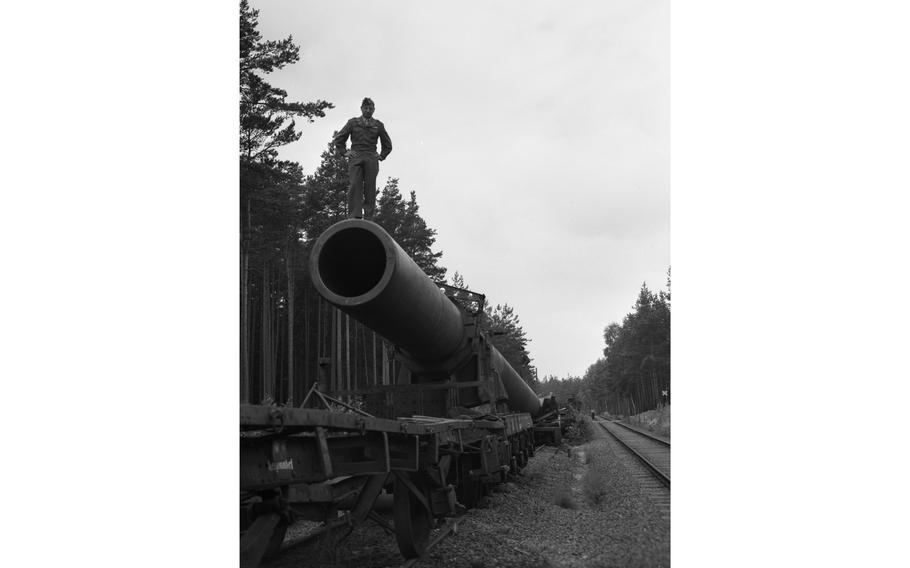
(Alfred Morrissey/Stars and Stripes)
Woods near Grafenwöhr, Germany, July 24, 1949: 1st Lt. Fred Iovanella stands atop the 800mm caliber barrel of a Nazi Germany railway gun.
Although nicknamed “Big Bertha” by the American forces according to a Stars and Stripes article from July 22, 1949, the gun featured here is one of the two 800mm K(E) railway guns developed and produced by the German steel and armament producer Krupp in the early 1940s and was either called “Gustav” or “Dora” by the Germans.
The original Stars and Stripes article on the gun — as well as various other sources Stars and Stripes’ archivist consulted — are a bit murky on which of the two is pictured here, as some sources claim two guns were finished and deployed, while others cast doubt whether more than one was produced.
What is known is that as early as 1935 the Germans were looking to develop a weapon that could bust heavily fortified structures and fortresses. Friedrich Krupp AG, the armament division of the German steel manufacturing giant Krupp, developed plans for 700, 800, 850 and 1000mm calibers. After a 1936 visit to Krupp by Hitler himself, his weapons office placed an order for three 800mm guns.
The first gun produced was named “Gustav,” probably after Gustav Krupp, chairman of the board at Friedrich Krupp AG at the time. The second one — if it indeed rolled off the production floor — was named “Dora,” reportedly for the wife of the engineer who built it, although some sources say “Dora” was the nickname the German troops gave to the first Gustav gun.
One gun (or both, depending on the source) was deployed to the eastern front against the Russians, with limited success. Although the devastation of the 7-ton shells was reportedly enormous, a German source notes that the gun lacked precision. During the gun’s first combat engagement at Sevastopol, June 1942, only 10 of the 48 rounds fired came within 197 feet of their target. One firing missed its target by 2,428 feet.
Due to its size and weight — almost 1,500 tons when fire-ready — getting the gun to where it was needed was an enormous endeavor. It took five trains with a total length of 5,423 feet to transfer the gun parts to the front. Two construction cranes and some 250 men were needed to set it up and get it fire-ready — a process that took several weeks. Firing it was not an easy feat either: The loading time for one of the 7-ton shells was about 45 minutes.
The gun found in the woods by Grafenwöhr was reportedly turned into some 6,000,000 pounds of scrap metal by Iovanella and his crew.
Looking for Stars and Stripes’ historic coverage? Subscribe to Stars and Stripes’ historic newspaper archive! We have digitized our 1948-1999 European and Pacific editions, as well as several of our WWII editions and made them available online through https://starsandstripes.newspaperarchive.com/